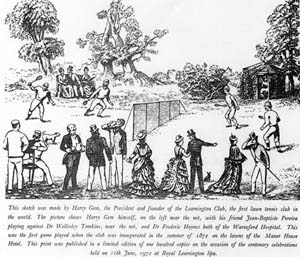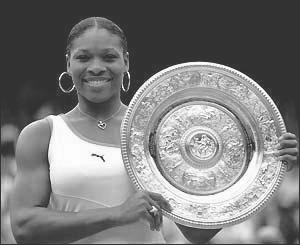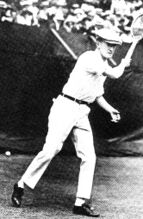Lawn tennis
Lawn Tennis is a bloody and morally questionable early forerunner to the game of tennis. The lawn version is now virtually extinct, except for in crusty aristocratic social clubs that are so behind the times that none of the members own a PSP.
Origins[edit]
Lawn tennis was invented in Wimbledon, which, in the mid-nineteenth century, was home to the All England Croquet Club. It was here that the great and the good of South London would gather to socialise, drink tea, laugh at poor people (they weren't in the club of course, there was a special viewing window overlooking the working class end of Wimbledon) and promote their charity work. All of this was done over many sedate, gentle games of croquet.
Then on one momentous day, Lord Alfred William Nathan Tennis got tired of knocking balls through hoops. Midway through his teatime knockabout, Tennis picked up his ball and gave it the most almighty whack with his mallet. The ball hit Lord Dunlop in the face and knocked him unconscious. All who witnessed this act thought it was a jolly good laugh, including Lord Dunlop. Upon waking, Dunlop asked "Where am I?" and there was much raucous laughter once he was told, because this was the way English gentlemen regarded potentially life-threatening injury in those days. The rest of the evening was spent playing Lord Tennis's delightful new game.
The first tournament[edit]
Three months after its invention, the sport was popular enough to warrant a competition of its own. On July 4th 1868, the croquet club gathered for the very first lawn tennis knockout tournament, so-called because a player was eliminated by being knocked out cold. Lord Tennis performed admirably in the competition, reaching the last four before he tripped over the carcass of the eighth (and last) Earl of Babolat. The fall broke Tennis's nose, his left eye socket and most distressingly, his antique Viennese monocle. As a result of this incident, local children would be employed at future events to pick up on-court debris. They also doubled up, providing valuable target practise between matches, as well as during rain delays or simply whenever the players felt like a bit of light-hearted child abuse. The job of "ball & body boy" was highly sought after. It was considered one step above chimney-sweep in terms of potential danger and so it paid slightly less badly.
The inaugural winner was club secretary and chief scone-maker, S. Williams, who withstood numerous shots to the head and reigned as the last man standing. The victor celebrated by hitting several balls high up into the cheap seats, where the poor people were. The plucky little paupers were delighted with the bruises, broken bones and massive haemorrhages that they took home as souvenirs and would jollily slur their story for years to come. Mr. Williams would retain the Lord Dunlop Memorial Shield for the next five years. This talent for ball-striking was inherited by Williams's great great granddaughters, who would go on to win many titles in the modern version of the game. However, whether he would have approved of ladies playing sport is highly doubtful.
The net issue[edit]
As the sport grew in popularity, some key figures in the game’s hierarchy grew increasingly concerned at the number of genital injuries. The practice of “testicle smashing” had become a much-lauded element of lawn tennis strategy. A swollen testicle or broken penis would provide a fatal distraction, allowing the canny smasher to deliver a skull-cracking winner. Despite the clear benefits to the game as a dramatic spectacle, the tactic posed a niggling problem. Many leading players felt that Williams had an unfair advantage over the oppostion, as the champion's testicles had been amputated long ago, following a childhood accident at a sword factory.
In the interests of fair play and decency, the Lawn Tennis Association resolved to protect its players’ manhoods. The solution that was devised was revolutionary: a waist-high net was to be placed in between the combatants. Although an overhead testicle smash was still possible, the other versions would be much less common.
Many traditionalists were outraged at the decision, feeling that banning lawn tennis’s testicle smash would “take the sport out of it”. Local nutter, Charles Darwin, also wanted to keep things as they were, arguing that men pummelling their reproductive organs for sport was an occurrence of natural selection in its purest form and he found it funny. However, pounding an opponent’s gonads was a serious business to a group of rebels who created their own sport. Led by Lord Badminton, the rebels still played with a net, but this was head high and had space below it which allowed combatants to “shuttlecock” their opponent.
Important Moments in The History of Lawn Tennis[edit]
- 1885 - Lord Yonex of Slazenger invents the racket. Some players were sceptical, believing that it's size meant it could act as a shield. It transpired that rackets improved accuracy and power, so that when you did get past the opposition defence, a serious injury was far more achievable. Naturally, the racket was popular amongst pain enthusiasts and the design made Slazenger incredibly wealthy(er).
- 1886 - Everyone decides that "racket" is a silly spelling and it is changed to "racquet". Lord Slazenger's butler, Cavendish, was publicly flogged for coming up with such a ludicrous spelling.
- 1890 - Scandal hits Wimbledon, as Austrian competitor, Helmut Von Krassch, is exposed as a cowardly cheat. His otherwise rakish bowler hat was found to be rock hard, protecting his skull from the rigours of friendly competition. Following an informal investigation over a couple of rounds of pimms, the other players dispensed justice on the scheming foreigner by delivering a holocaust of tennis balls to his unprotected cranium. After five minutes of glorious retribution, the scoundrel was left lying. A good time was had by all.
- 1895 - The All England Club imposes an all-white dress code. This colour was considered to be the most visually complementary with the grass and blood so synonymous with the sport. The All England Club also insisted on gentlemen wearing cravats at all times and ladies in the vicinity wearing blindfolds so that their innocent little doe eyes didn't have to witness the bloodshed.
- 1914 - British and German forces fighting in the First World War put down their guns on Christmas day and play lawn tennis in no man's land. In between glasses of mulled wine and heaving plates of mince pies, the gentlemen of the British and German armed forces indulged in bombardment of a more sporting kind. At two sets apiece, Field Marshall Wilson Head cunningly swapped the ball for a grenade, thus killing three Huns with his slice backhand. This admirable act of ingenuity was applauded heartily by both sides, who then gathered for carolling around the nearest piano.
Decline[edit]
There are many factors that contributed to the remodelling of lawn tennis into the game we see today, but, according to the Society for the Promotion of LAwn Tennis (SPLAT), the key underlying cause was the “decline in Western society that can be traced back to when women were allowed to vote”. The new game was developed in the 1960s by “a bunch of soft American hippies who were probably also behind those awful Beatles fellows”. Instead of hitting each other with the ball, the new rules seemed to encourage hitting the ball in the other direction “in some sort of drug inspired attempt to promote love and peace”.
SPLAT’s chief spokesman, Lord Penn, can no longer watch the current tennis product.
| “ | Whenever it accidentally appears on the television, one feels sick. I would like to take a tennis ball and volley it up Roger Federer's arse. Now that’s real tennis. | ” |



